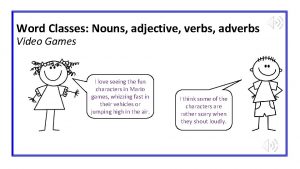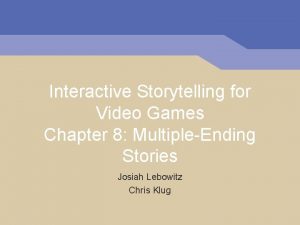Interactive Storytelling for Video Games Chapter 14 What


















- Slides: 18

Interactive Storytelling for Video Games Chapter 14: What Players Really Want Josiah Lebowitz Chris Klug

The Most Important Issue § In the end, the arguments for both traditional and playerdriven storytelling come down to what players want and enjoy most in game stories. § People tend to make assumptions about what players want, rather than doing any serious research on the matter. § In order to reach proper conclusions, solid data is needed. § The following data has been compiled from two national surveys on game storytelling preferences run by Josiah Lebowitz in 2009 and 2010.

Do players know what they really want? § Giving the player control over a story’s progression can lead to him unwittingly turn the story down a less interesting path. § It’s possible that some players who say they prefer highly player-driven stories actually enjoy traditional storytelling styles more. § It’s important to check for these unconscious preferences. § If there is a large disconnect between players’ stated preferences and unconscious preferences it implies that even the players themselves don’t realize what they want most.

How important are game stories? § For the vast majority of players, story is a very important part of the games they play. § Nearly 70% of respondents pay close attention to game dialogue and cut-scenes. § Less than 10% pay little or no attention to them. § Many respondents said that a poorly told story can ruin an otherwise good game. § Story preferences remain consistent among players regardless of age and gender. § Game genres known for their stories are the most popular while those which often have no stories are the least popular.

Favorite Game Genres

What Players Say They Want § When asked directly which storytelling style they preferred in games, the majority of respondents chose interactive traditional storytelling. § Multiple-ending stories are the second most popular style with branching path stories in third. § Highly player-driven forms of storytelling (open-ended and fully player-driven stories) rank very low. § This strongly indicates that players value a well structured story over the ability to do what they want and change the story.

Preferred Storytelling Styles § ITS = Interactive Traditional Storytelling § MES = Multiple-Ending Storytelling § BPS = Branching Path Storytelling § HPDS = Highly Player-Driven Storytelling (Open-Ended and Fully Player-Driven) § NS = No Story § NP = No Preference

What Players Really Want § To determine unconscious preferences, respondents were asked to list three games which they felt had exceptionally good stories. § The final list contained 199 unique games and 24 series. § The games were organized based on the type of storytelling they use. § The first chart compares only the unique games and series from the list. § The second chart also accounts for how many respondents nominated each game and series.

Best Game Stories ITS = Interactive Traditional Story MES = Multiple-Ending Story BPS = Branching Path Story OES = Open-Ended Story FPDS = Fully Player Driven Story NS = No Story NA = Not Applicable U = Unsure

What Players Really Want § Interestingly, the two charts are nearly identical. § Games with interactive traditional stories score over 60% on both charts, more than double their rating in the respondents’ stated storytelling preferences. § Compared to the respondents’ stated preferences, the popularity of multiple-ending and branching path stories dropped significantly. § Open-ended and fully player-driven stories still ranked very low. § The five most frequently listed games were (in order): § § 1. FINAL FANTASY VII (interactive traditional story) 2. CHRONO TRIGGER (multiple ending story) 3. Xenogears (interactive traditional story) 4. & 5. (tie) § FINAL FANTASY X (interactive traditional story) § Mass Effect (multiple-ending story).

Further Analysis § Interactive traditional stories are clearly the most popular when looking at both respondents’ stated and unconscious preferences. § In general, the more player-driven the storytelling style, the less popular it is among players. § Players seem to like having some control, but enjoy a good well structured story over all else. § Highly player-driven stories could become a bit more popular over time as designers, writers, and players become more accustomed to them. § However, it’s highly unlikely that they’ll ever overtake more traditional stories in popularity.

Do stories sell games? § In many ways, how many people buy a game is more important than how much they enjoy it. § 40% of respondents frequently buy games primarily for their stories. § Less than 14% rarely or never do so. § Respondents listed the three most important factors they consider when buying games. § At 52%, story was the most important one.

The most important story elements. § Respondents named plot as the most important story element when buying games. § Plot can be difficult to accurately judge before playing a game. § Players often buy games by developers they know have a reputation for good storytelling. § Others look to reviews or seek advice from friends.

Buying Habits and Stories § 50% of respondents said that a high degree of interactivity and freedom would make them more likely to purchase a game. 45% said they don’t care. § But, as interactivity only scored 15% in the previous chart, it’s not a key factor in most players’ purchasing decisions. § To determine unconscious preferences, respondents were asked to list three games which they had purchased primarily for their stories. § The final list contained 174 unique games and 17 series. § The games were organized based on the type of storytelling they use. § The first chart compares only the unique games and series from the list. § The second chart also accounts for how many respondents nominated each game and series.

Games Bought for Their Story FTS = Fully Traditional Story ITS = Interactive Traditional Story MES = Multiple-Ending Story BPS = Branching Path Story OES = Open-Ended Story FPDS = Fully Player Driven Story

Buying Habits and Stories § Interestingly, both charts are nearly identical. § The breakdown of storytelling styles is very close to that of the best game stories charts. § Interactive traditional stories dominate both charts. § The five most frequently listed games were (in order): § 1. Dragon Age: Origins (multiple-ending story) § 2. & 3. (tie) § Bioshock (multiple-ending story) § Final Fantasy XIII (interactive traditional story) § 4. & 5. (tie) § Heavy Rain (branching path story) § Mass Effect (multiple-ending story)

Further Analysis § Interactive traditional storytelling remains the most popular. § Once again, the more player-driven the storytelling style, the less popular it is among players. § While players like having some degree of interactivity and control (or at least think they do), it’s not a major factor when deciding which games to buy. § Players tend to focus on the strength of the plot rather than the amount of interactivity and control. § It seems very unlikely that highly player-driven forms of storytelling will ever overtake more traditional ones.

Things to Consider § Do you agree with the survey results and conclusions? Why or why not? § Was there anything in the survey results that you found particularly surprising? Why? § Did the information presented in this chapter change your opinion about which type of storytelling is best? Why or why not? § Think about your answers regarding traditional vs. playerdriven storytelling from previous sections and discuss how and why your views on the matter have or haven’t changed.
 Interactive storytelling for video games
Interactive storytelling for video games Digital storytelling script examples
Digital storytelling script examples Interactive capacity games
Interactive capacity games Chapter 20 guiding storytelling experiences
Chapter 20 guiding storytelling experiences Hunger games chapter 23
Hunger games chapter 23 Types of games indoor and outdoor
Types of games indoor and outdoor Thesis statement about education
Thesis statement about education Originality in video games
Originality in video games Columbine shooting video
Columbine shooting video Valve corporation video games
Valve corporation video games My.com video games
My.com video games Baki video games
Baki video games Nouns for video games
Nouns for video games Santos
Santos Hevga
Hevga Capstone video games
Capstone video games Capstone video games
Capstone video games Video games
Video games Video games that teach history
Video games that teach history


































